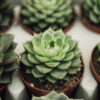Echeveria is a diverse and popular genus of succulent plants belonging to the Crassulaceae family. These plants are native to regions of Central and South America, particularly Mexico, and are highly valued for their stunning rosette-shaped foliage, variety of colors, and ease of care. Echeverias are commonly grown as ornamental plants in gardens, landscapes, and indoor settings.
Care of Echeveria:
Light : These plants prefer bright, indirect light. They can tolerate some direct sunlight, especially in the morning or late afternoon, but too much intense sunlight may cause sunburn or damage to the leaves. Indoors, place them near a sunny window with filtered light.
Temperature : These plants thrive in warm temperatures and are best suited for tropical and subtropical climates. They are sensitive to frost and should be protected from freezing temperatures.
Watering : These plants are succulent plants and have the ability to store water in their leaves. As a result, they are drought-tolerant and prefer to dry out between waterings. Water them thoroughly but allow the soil to dry out before watering again. Overwatering can lead to root rot.
Soil : A well-draining and porous potting mix is essential for this plant. A cactus or succulent-specific mix or a blend of regular potting soil with perlite or sand for added drainage is suitable.
Humidity : These plants prefer low to moderate humidity levels, making them well-suited for indoor environments.
Fertilization : These plants do not require frequent fertilization. During the active growing season and summer), a balanced, diluted liquid fertilizer can be applied every 2-4 weeks.
Characteristics of Echeveria:
Rosettes: These plants form beautiful rosettes, which are clusters of thick, fleshy leaves arranged in a circular pattern. The rosettes can be small and compact or larger, depending on the species and growing conditions.
Leaves: The leaves of these plants are typically thick, succulent, and often have a waxy or powdery coating called “bloom,” which gives them a unique appearance. The leaf colors vary among species and can include shades of green, blue, pink, purple, red, and silver. Some varieties also have edges or tips that are accented with contrasting colors.
Flowers: These plants produce lovely, bell-shaped flowers that arise from tall, slender stalks called inflorescences. The flower colors can range from white to various shades of pink, red, yellow, or orange, depending on the species.
Landscape Use of Echeveria:
Echeverias are commonly grown in containers, succulent gardens, and rock gardens.
They are also popular choices for dish gardens and indoor arrangements, adding beauty and texture to these displays.
Echeverias can be used in outdoor landscapes in warm climates, provided they are protected from frost and receive proper sunlight.
Overall, Echeverias are beloved for their attractive rosette form, vibrant colors, and ease of care. Whether grown indoors or outdoors, these succulents are a wonderful addition to any garden or collection, and their unique shapes and colors make them highly sought-after by succulent enthusiasts and plant lovers alike.








